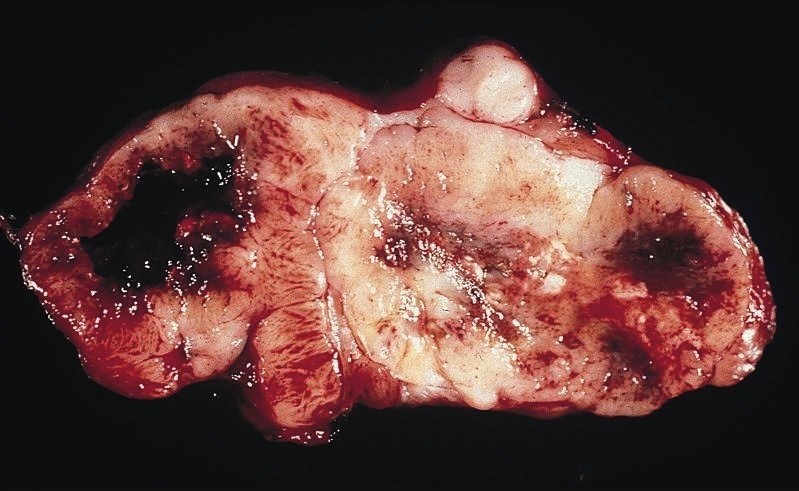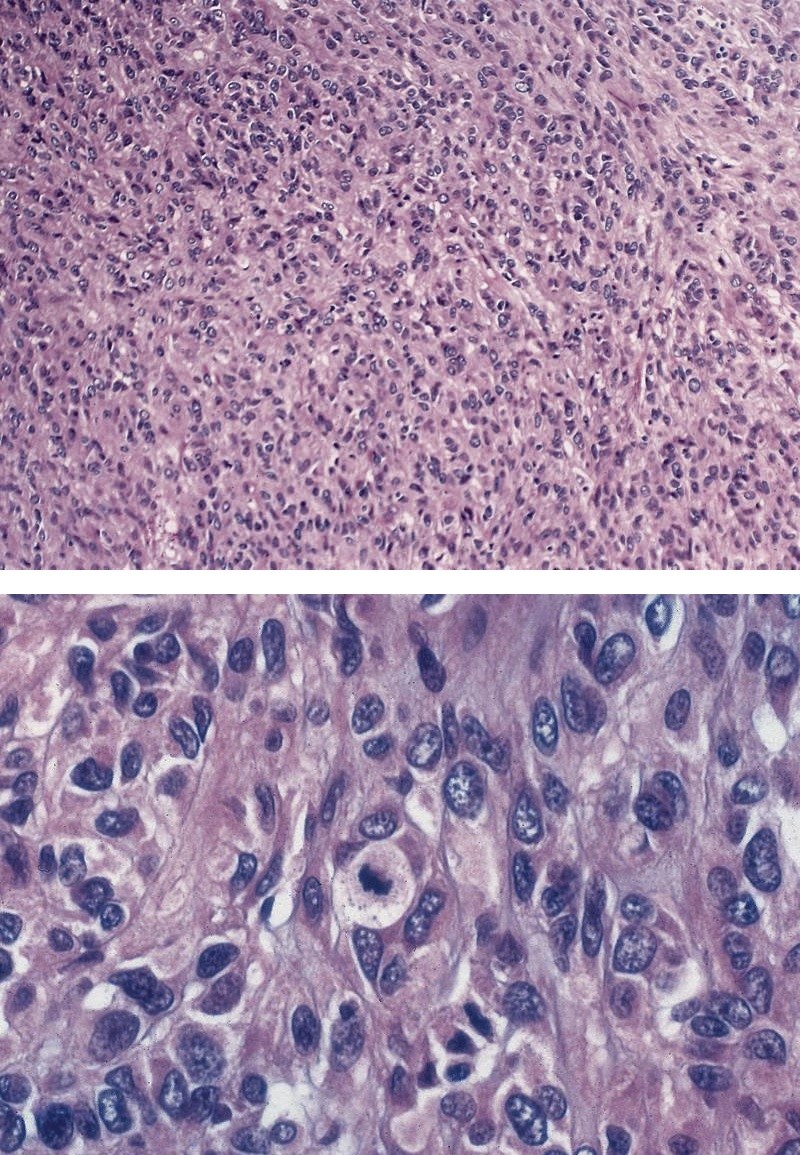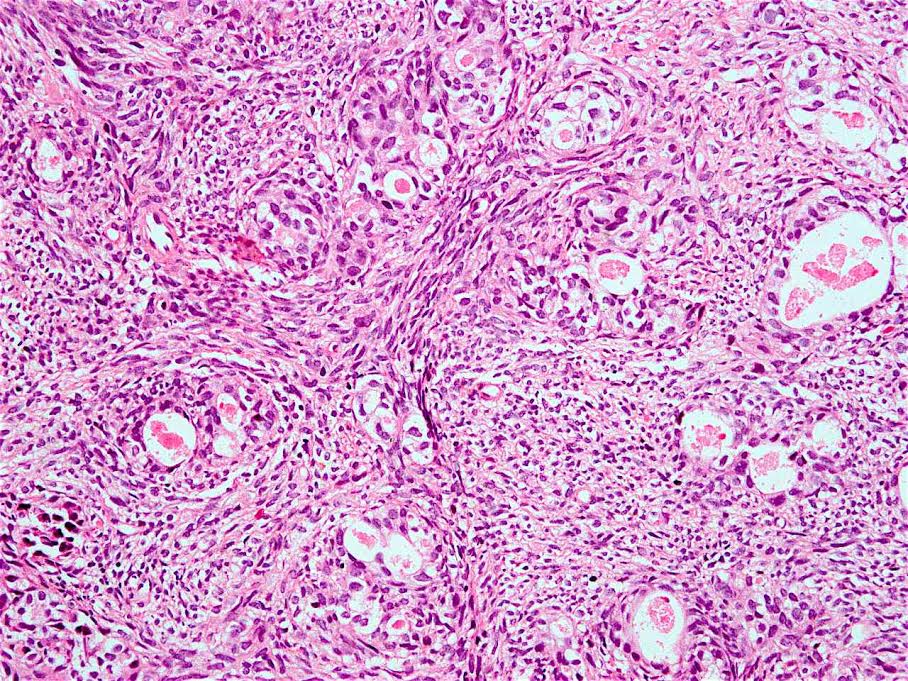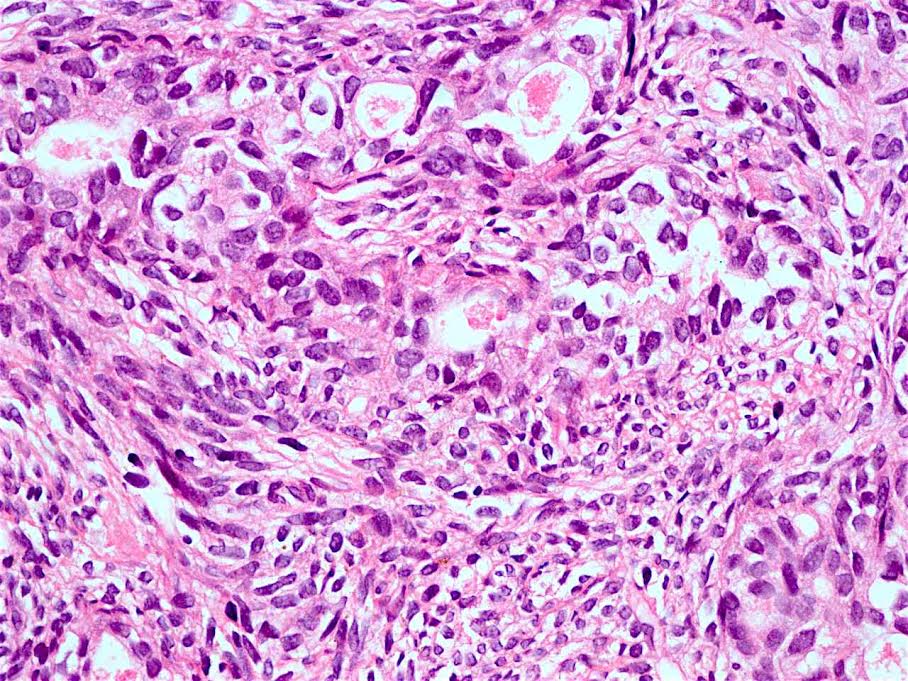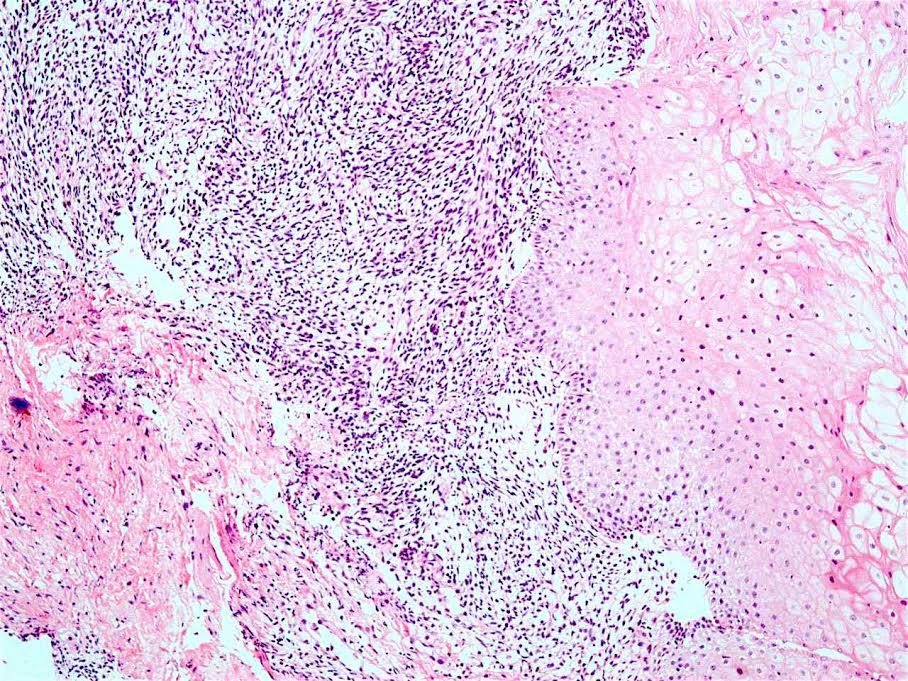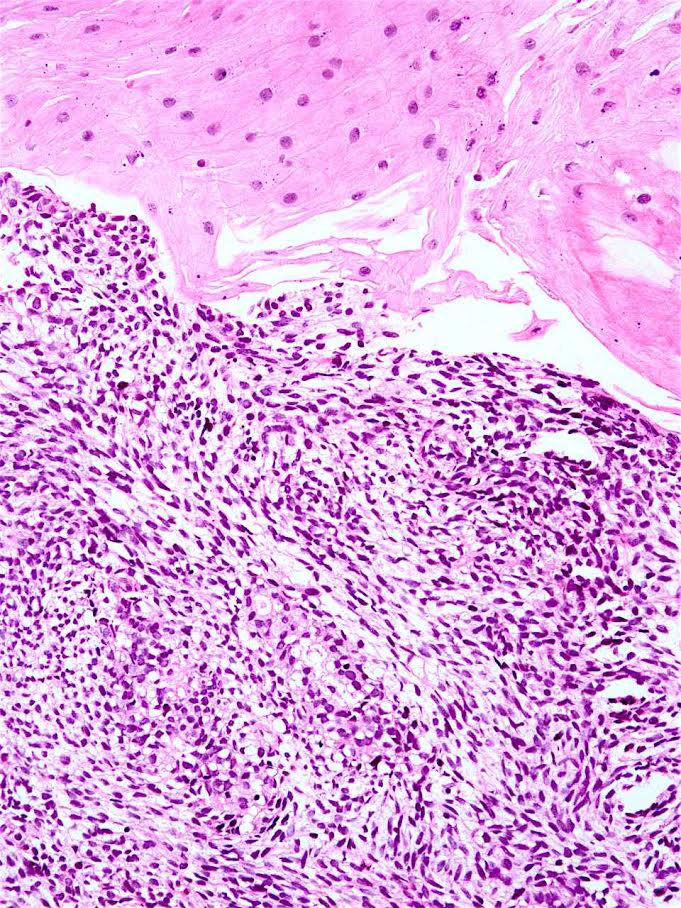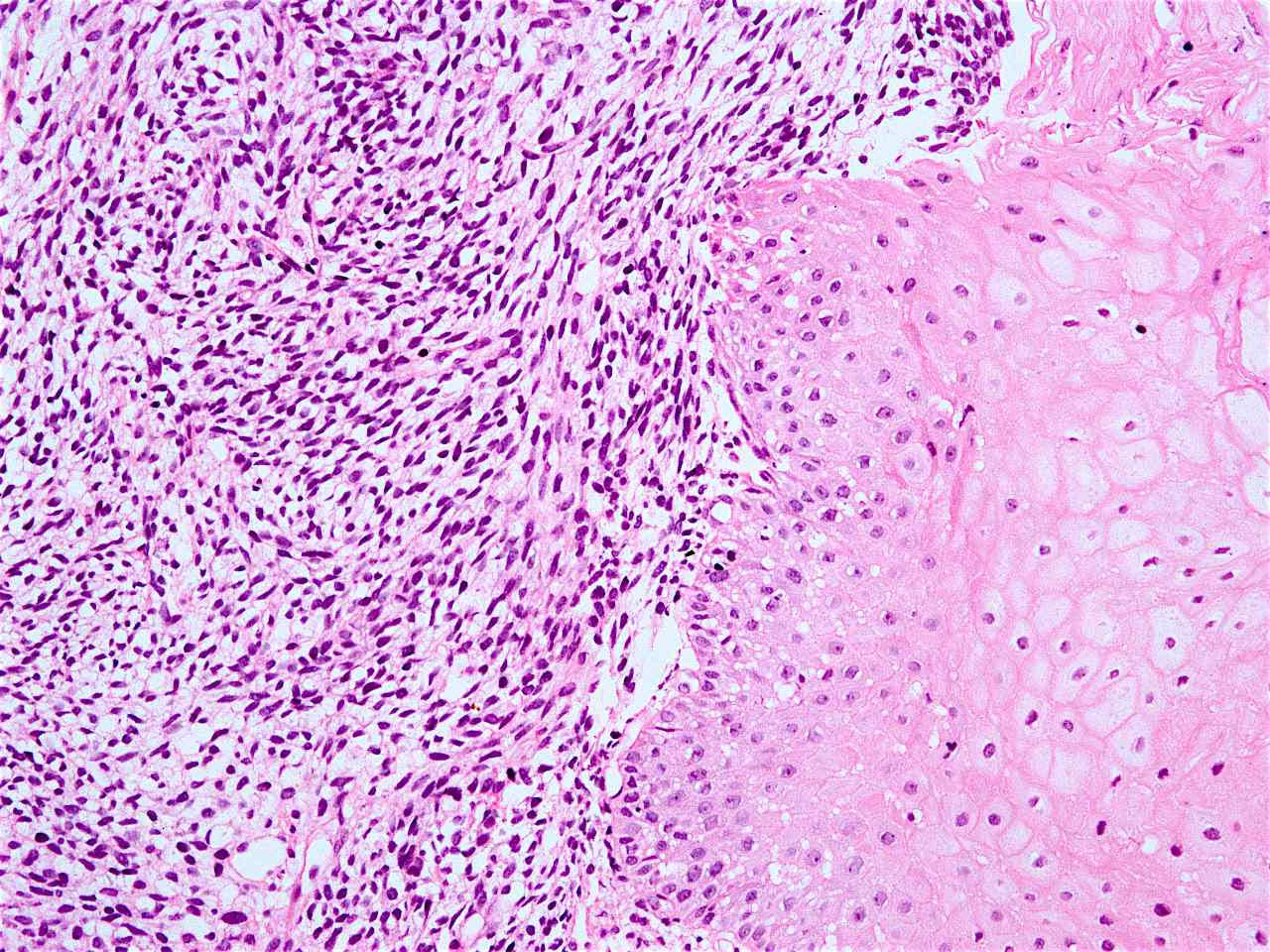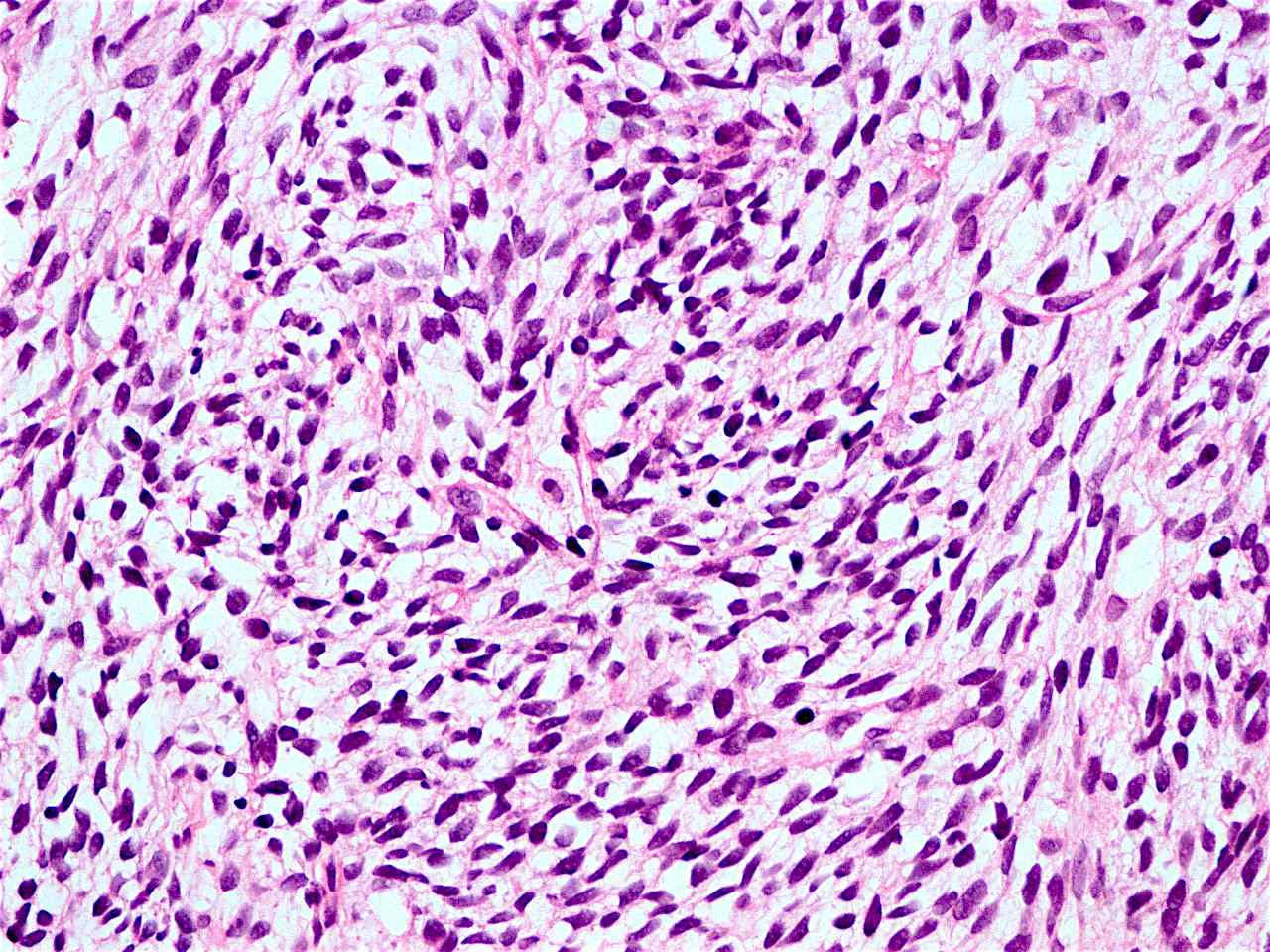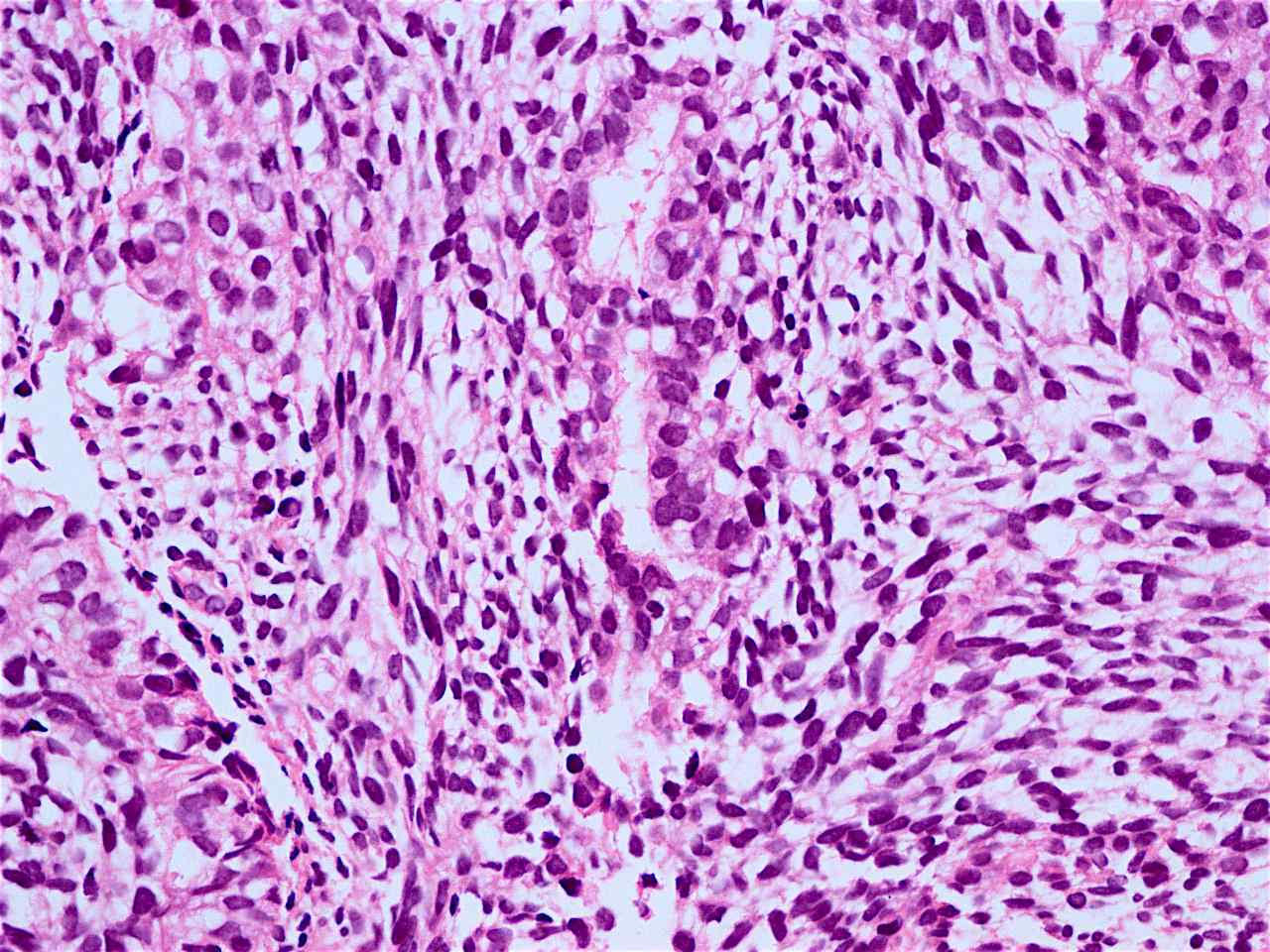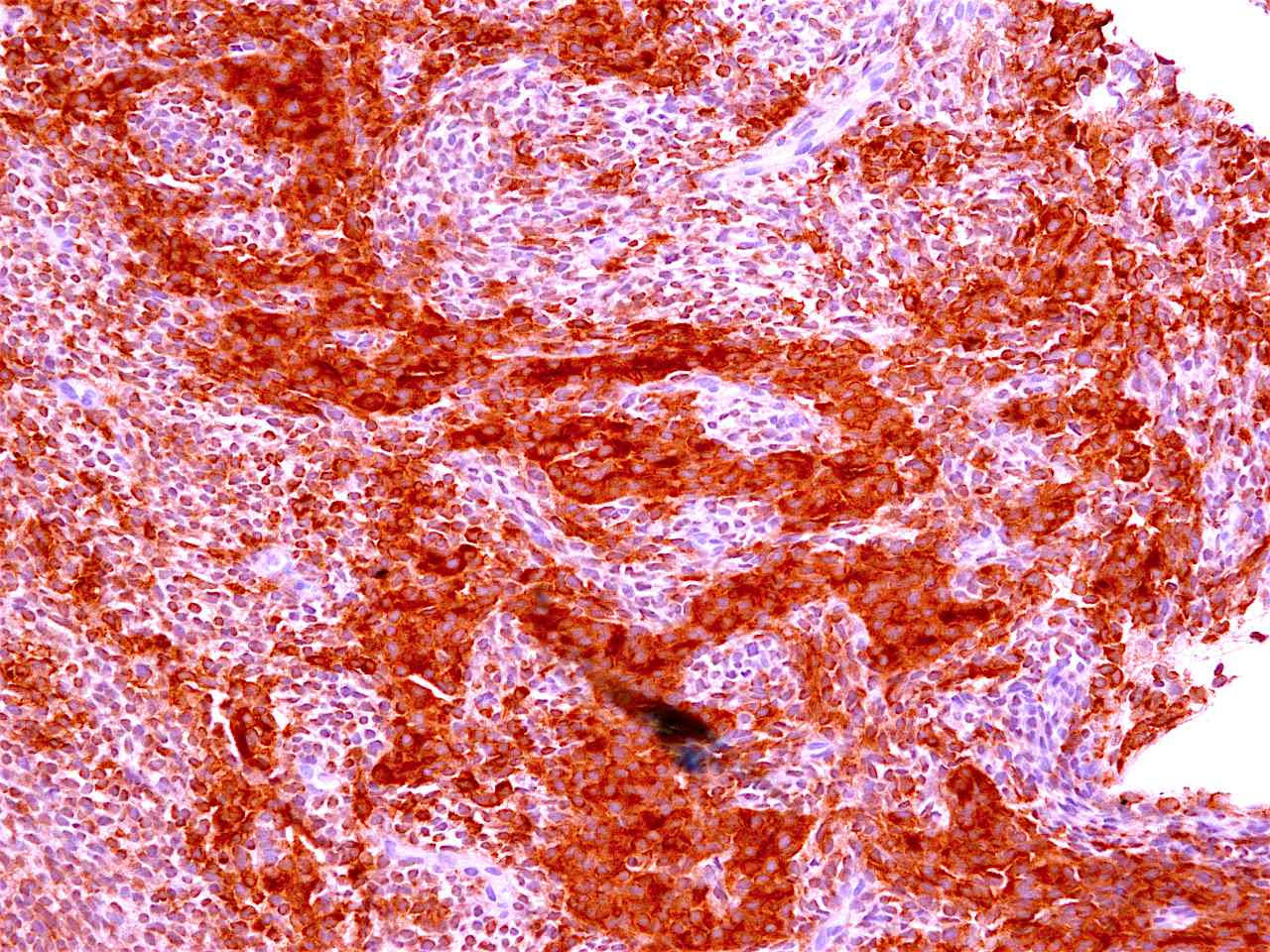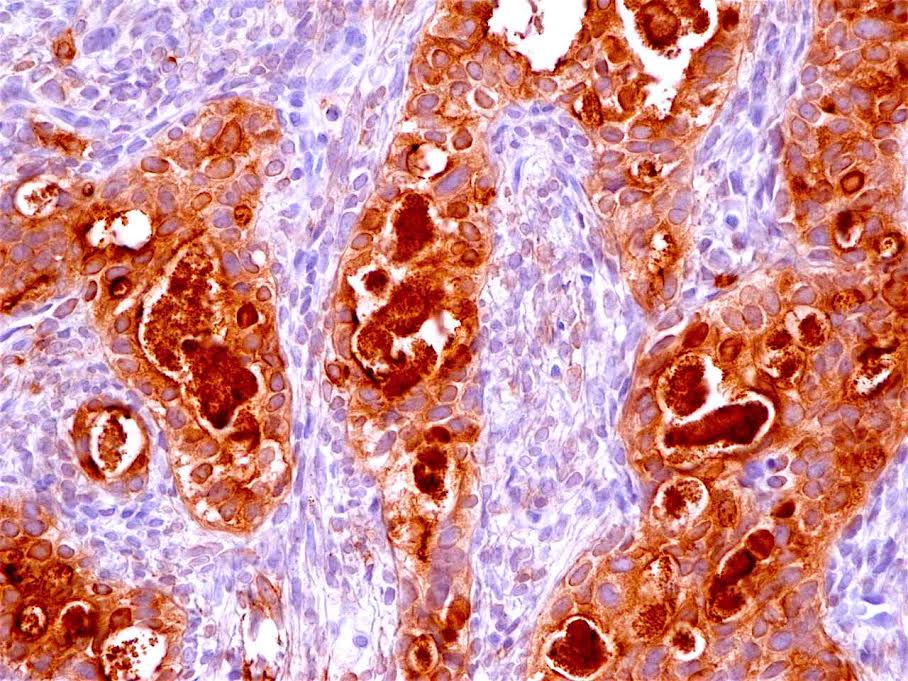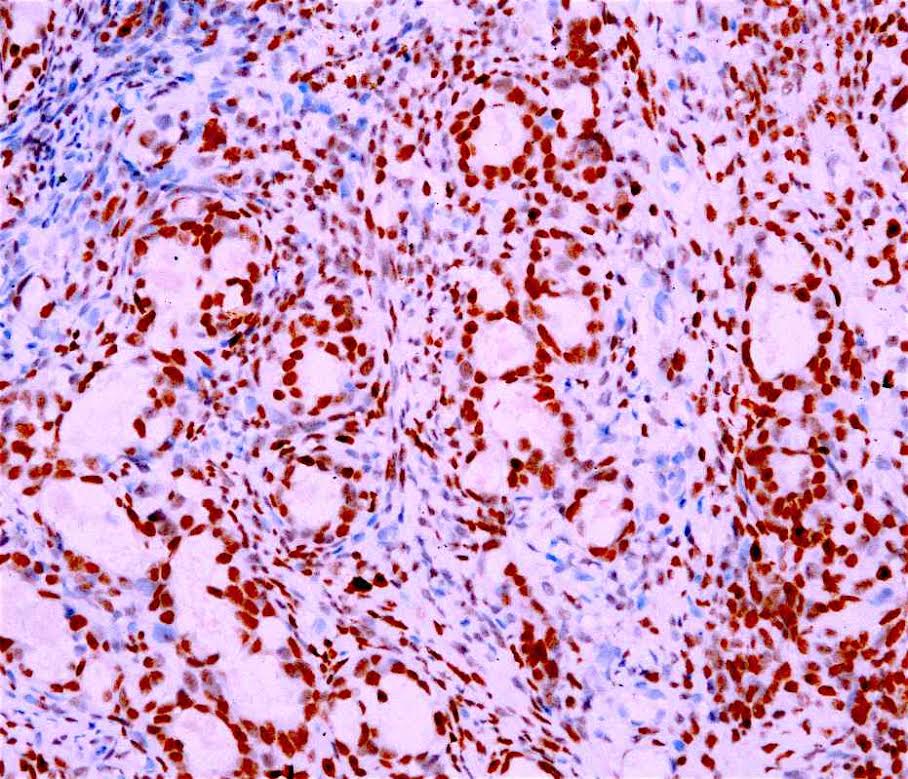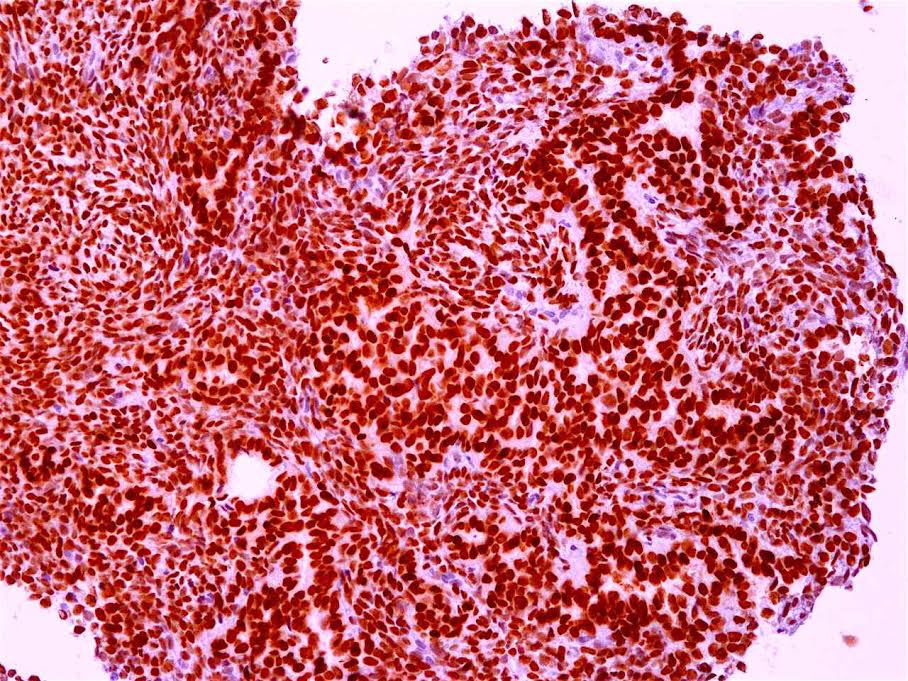Table of Contents
Definition / general | Epidemiology | Sites | Clinical features | Diagnosis | Radiology description | Radiology images | Prognostic factors | Treatment | Clinical images | Gross description | Gross images | Microscopic (histologic) description | Microscopic (histologic) images | Positive stains | Flow cytometry description | Electron microscopy description | Molecular / cytogenetics description | Differential diagnosis | Additional referencesCite this page: Bhaijee F, Akhtar I. Esophageal sarcoma-overview. PathologyOutlines.com website. https://www.pathologyoutlines.com/topic/esophagussarcomagen.html. Accessed March 31st, 2025.
Definition / general
- Malignant mesenchymal tumors of the esophagus with variable degrees of differentiation, biologic behavior and prognosis
- Examples
- Angiosarcoma: high grade malignancy of endothelial cells
- Ewing sarcoma: highly malignant small round blue cell tumor characterized by recurrent chromosomal translocations [t(11;22) EWSR1-FLI1 or t(21;22) EWSR1-ERG] and membranous MIC2 / CD99 overexpression
- Fibrosarcoma: spindle cell neoplasm of low grade to intermediate grade malignancy
- Gastrointestinal stromal tumor (GIST): mesenchymal tumor of digestive tract, likely originating from multipotential progenitors of interstitial cells of Cajal
- Hemangiopericytoma (solitary fibrous tumor): ubiquitous mesenchymal tumor showing uncertain line of differentiation (not true microvascular pericytes)
- Kaposi sarcoma: uncommon, low grade, vascular malignancy caused by Kaposi sarcoma herpesvirus / human herpesvirus 8 (KSHV / HHV8) infection
- Leiomyosarcoma: malignant smooth muscle tumor
- Liposarcoma: malignant adipocytic / lipomatous tumor
- Malignant peripheral nerve sheath tumor (MPNST): malignant tumor arising from peripheral nerve or a neurofibroma or in extraneural soft tissue and showing nerve sheath differentiation
- Osteosarcoma: mesenchymal malignancy characterized by neoplastic cells that produce osteoid matrix
- Synovial sarcoma (SS): malignant mesenchymal tumor showing epithelial differentiation, either overtly (biphasic SS) or by IHC alone (monophasic SS)
- Undifferentiated pleomorphic sarcoma: highly malignant pleomorphic neoplasm lacking any specific line of differentiation
Epidemiology
- Extremely rare
Sites
- Likely arise from submucosal or intramural elements
Clinical features
- Asymptomatic mass
- Obstructive features: dysphagia, odynophagia, nausea, vomiting
Diagnosis
- Biopsy or resection with immunohistochemical or molecular ancillary studies
Radiology description
- Highly variable
- Destructive mass with variable hemorrhage or necrosis
- Strictures or obstruction
Radiology images
Prognostic factors
- Poor prognostic factors
- High histologic grade
- Cytologic atypia, nuclear pleomorphism
- Necrosis
- Mitotic activity
- High histologic grade
- Poor degree of differentiation
Treatment
- Treatment options depend on type of sarcoma and clinical stage
- Treatment modalities include surgery, chemotherapy, radiotherapy
Gross description
- Often large tumor with infiltrative margins and variable hemorrhage, necrosis
Microscopic (histologic) description
- Highly variable
- Round blue cell tumors: Ewing sarcoma, small cell variant of osteosarcoma
- Spindle cell tumors: angiosarcoma, fibrosarcoma, GIST, hemangiopericytoma, Kaposi sarcoma, leiomyosarcoma, MPNST, synovial sarcoma
- Adipocytic differentiation: liposarcoma
- Osteoid production: osteosarcoma
- Undifferentiated: pleomorphic sarcoma
Microscopic (histologic) images
Positive stains
- Angiosarcoma: endothelial markers (factor VIII related antigen, CD31, CD34)
- Ewing sarcoma: MIC2 / CD99 (100% sensitive but not specific), FLI1 gene product (90%), neuron specific enolase, vimentin, p53
- GIST: CD117 / c-kit, DOG1, CD34, focal SMA, focal desmin, focal S100
- Hemangiopericytoma: CD34 (95%), CD99 (70%), CD57 (50%), focal nuclear beta catenin
- Kaposi sarcoma: HHV8, factor VIII related antigen, CD34, CD31, FLI1, D2-40, VEGFR3, BCL2
- Leiomyosarcoma: smooth muscle markers (SMA, desmin, caldesmon, calponin)
- Liposarcoma: S100 (lipogenic zones); MDM2, CDK4 (well differentiated tumors)
- MPNST: S100 (weak / focal in spindled MPNST, diffuse / strong in epithelioid MPNST)
- Synovial sarcoma: focal high molecular weight cytokeratin
- Undifferentiated pleomorphic sarcoma: CD68
Flow cytometry description
- Useful to exclude hematopoietic malignancies
Electron microscopy description
- Angiosarcoma: Weibel-Palade bodies
- Ewing sarcoma: extensive cytoplasmic glycogen deposits
- Hemangiopericytoma: undifferentiated spindle cell or fibroblastic features
- Leiomyosarcoma: features of smooth muscle differentiation (thin filaments, pinocytic vesicles, attachment plaques, interrupted external lamina)
- Liposarcoma: nonmembrane bound intracytoplasmic lipid droplets of varying sizes / densities
- MPNST: tumor cells with external laminae, indicating schwannian differentiation
- Osteosarcoma: osteoid matrix comprises nonperiodic fibrils, scattered collagen fibers and hydroxyapatite calcium crystals
Molecular / cytogenetics description
- RT PCR or FISH
- Ewing sarcoma: recurrent chromosomal translocations including t(11;22)(q24;q12) EWS-FLI1, t(21;22)(q22;q12) EWS-ERG, t(7;22) EWS-ETV1, t(17;22) EWS-E1AF, t(2;22) EWS-FEV
- GIST: mutually exclusive mutations of activating KIT (95%) or platelet derived growth factor alpha (PDGFRA) receptor tyrosine kinase (5%)
- Kaposi sarcoma: HHV8 detected by PCR
- Leiomyosarcoma: no consistent genetic events reported
- Well differentiated liposarcoma: giant marker or supernumerary ring chromosomes with amplification of 12q12-15 region, including MDM2, CDK4 and other genes
- Myxoid / round cell liposarcoma: t(12;16) DDIT3-TLS or t(12;22) DDIT3-EWS balanced translocations
- Synovial sarcoma: characteristic t(X;18) SSYT-SSX1 / 2 translocations
Differential diagnosis
- Benign spindle cell proliferations, e.g.
- Inflammatory fibroid polyp: PDGFRA+, CD34+, CD117-, mixed inflammatory infiltrate (especially eosinophils)
- Leiomyoma: rare atypia, mitotic activity, or necrosis
- Ossifying fibromyxoid tumor: usually bland cytology and peripheral ossification
- Schwannoma: diffuse S100+, Verocay bodies
- Lymphoma: usually CD45 (LCA)+, flow cytometry may be diagnostic
- Melanoma: melanoma markers+ (S100, HMB45, MART, MITF, MelanA, SOX10, tyrosinase)
- Other round blue cell tumors, e.g.
- Alveolar rhabdomyosarcoma: desmin+, myogenin+, myoD1+
- Desmoplastic small round cell tumor (DSRCT): striking desmoplasia, coexpression of cytokeratin / desmin, WT1+
- Glomus tumor: round to polygonal cells with scant cytoplasm and marked cellularity uniformity; SMA+, desmin-, S100-
- Neuroendocrine (small cell) carcinoma: neuroendocrine markers+ (CD56, chromogranin, synaptophysin)
- Poorly differentiated carcinoma: focal cytokeratin+











